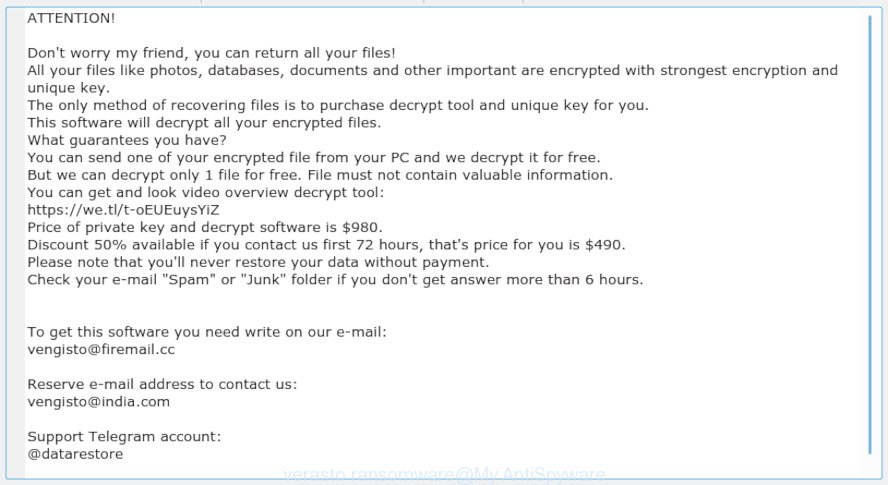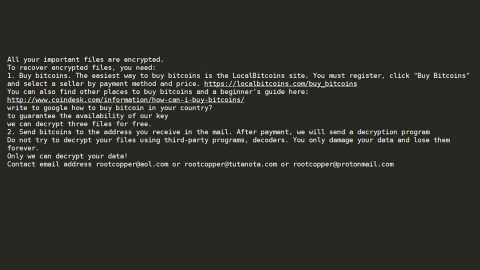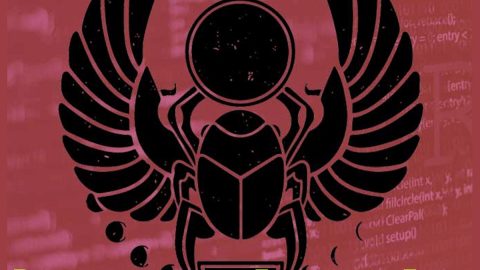What is Verasto ransomware? And how does it execute its attack?
Verasto ransomware is a dangerous file-encrypting virus that can leave files unusable to users. It is one of the latest variants of Djvu ransomware. It seems that developers of this ransomware group have been active in the month of April 2019 as they keep releasing new variants of Djvu ransomware.

Once its malicious payload is dropped in the system, Verasto ransomware will implement a series of modifications. It starts by connecting the computer to a remote Command and Control or C&C server controlled by the attackers. From this remote server, Verasto ransomware will download its other malicious components and puts them in several system folders which allow it to launch and repress system processes.
Following infiltration and some system modifications, it employs a data harvesting module to gather sensitive data from the system. It also employs a stealth protection module that allows it to evade security and antivirus programs installed in the system that might interrupt its attack. It then scans the entire computer in search of targeted files that are mostly user-generated. After it finds these files, it encrypts them using a special cipher that leaves the files inaccessible. It then adds the “.verasto” extension to each one of them and drops a text file named “_readme.txt” that states:
“ATTENTION!
Don’t worry my friend, you can return all your files!
All your files like photos, databases, documents, and other important are encrypted with the strongest encryption and unique key.
The only method of recovering files is to purchase a decrypt tool and unique key for you.
This software will decrypt all your encrypted files.
What guarantees do you have?
You can send one of your encrypted files from your PC and we decrypt it for free.
But we can decrypt only 1 file for free. The file must not contain valuable information.
You can get and look video overview decrypt tool:
hxxps://we.tl/t-aSdhfTOs1G
The price of the private key and decrypt software is $980.
Discount 50% available if you contact us first 72 hours, that’s the price for you is $490.
Please note that you’ll never restore your data without payment.
Check your e-mail “Spam” or “Junk” folder if you don’t get an answer for more than 6 hours.
To get this software you need writes on our e-mail:
[email protected]
Reserve an e-mail address to contact us:
[email protected]
Support Telegram account:
@datarestore
Your personal ID:”
According to the ransom note, victims are asked to send one encrypted file to [email protected] email address and pay the $980 ransom to decrypt the encrypted files. The cyber crooks behind Verasto ransomware also try to entice users in paying the huge ransom amount by supposedly decrypting one encrypted file at no cost and giving them a “50% discount”, so instead of $980, it would only amount to $490. However, you shouldn’t to such demands as they are merely a ploy to get you to believe that the only way to recover the files is to contact them. And more importantly, if you are one of the unfortunate victims of Verasto ransomware, paying the ransom is not recommended as you will end up losing your money for nothing. You have to obliterate Verasto ransomware from your computer before you try to recover your files.
How does Verasto ransomware proliferate?
Verasto ransomware uses the typical distribution method that ransomware infections use these days which is via spam emails. These spam emails contain an attached corrupted file used to download and install Verasto ransomware into the system. This kind of email shouldn’t be hard to miss as it often stands out with its catchy subjects to lure users into opening them. So when you see any suspicious emails, the best way to deal with them is by deleting them right away.
Kill Verasto ransomware from your infected computer with the help of the following removal guide.
Step_1: First, tap the Ctrl + Shift + Esc keys on your keyboard to open the Task Manager.
Step_2: After opening the Task Manager, go to the Processes tab and look for a process named “Cossy.exe” as well as any suspicious-looking process that takes up most of your CPU’s resources and is most likely related to Verasto ransomware.
Step_3: After that, close the Task Manager.
Step_4: Tap Win + R, type in appwiz.cpl and click OK or tap Enter to open Programs and Features under Control Panel.
Step_5: Under the list of installed programs, look for Verasto ransomware or anything similar, and then uninstall it.
Step_6: Next, close the Control Panel and tap Win + E keys to launch File Explorer.
Step_7: Navigate to the following locations below and look for Verasto ransomware’s malicious components such as _readme.txt”, [random].exe, and other suspicious files, then delete all of them.
- %TEMP%
- %WINDIR%\System32\Tasks
- %APPDATA%\Microsoft\Windows\Templates\
- %USERPROFILE%\Downloads
- %USERPROFILE%\Desktop
Step_8: Close the File Explorer.
Before you proceed to the next steps below, make sure that you are tech-savvy enough to the point where you know exactly how to use and navigate your computer’s Registry. Keep in mind that any changes you make will highly impact your computer. To save you trouble and time, you can just use Restoro, this system tool is proven to be safe and excellent enough that hackers won’t be able to hack into it. But if you can manage Windows Registry well, then by all means go on to the next steps.
Step_9: Tap Win + R to open Run and then type in Regedit in the field and tap enter to pull up Windows Registry.
Step_10: Navigate to the following path:
- HKEY_CURRENT_USER\Control Panel\Desktop\
- HKEY_USERS\.DEFAULT\Control Panel\Desktop\
- HKEY_LOCAL_MACHINE\Software\Microsoft\Windows\CurrentVersion\Run
- HKEY_CURRENT_USER\Software\Microsoft\Windows\CurrentVersion\Run
- HKEY_LOCAL_MACHINE\Software\Microsoft\Windows\CurrentVersion\RunOnce
- HKEY_CURRENT_USER\Software\Microsoft\Windows\CurrentVersion\RunOnce
Step_11: Delete the registry keys and sub-keys created by Verasto ransomware.
Step_12: Close the Registry Editor and empty the Recycle Bin.
Try to recover your encrypted files using the Shadow Volume copies
Restoring your encrypted files using Windows Previous Versions feature will only be effective if Verasto ransomware hasn’t deleted the shadow copies of your files. But still, this is one of the best and free methods there is, so it’s definitely worth a shot.
To restore the encrypted file, right-click on it and select Properties, a new window will pop up, then proceed to Previous Versions. It will load the file’s previous version before it was modified. After it loads, select any of the previous versions displayed on the list like the one in the illustration below. And then click the Restore button.
Congratulations, you have just removed Verasto Ransomware Crypto-Malware in Windows 10 all by yourself. If you would like to read more helpful articles and tips about various software and hardware visit fixmypcfree.com daily.
Now that’s how you remove Verasto Ransomware Crypto-Malware in Windows 10 on a computer. On the other hand, if your computer is going through some system-related issues that have to get fixed, there is a one-click solution known as Restoro you could check out to resolve them.
This program is a useful tool that could repair corrupted registries and optimize your PC’s overall performance. Aside from that, it also cleans out your computer for any junk or corrupted files that help you eliminate any unwanted files from your system. This is basically a solution that’s within your grasp with just a click. It’s easy to use as it is user-friendly. For a complete set of instructions in downloading and using it, refer to the steps below
Perform a full system scan using Restoro. To do so, follow the instructions below.













